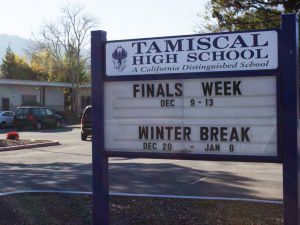The issue of homelessness is no stranger to Americans. Approximately 633,782 persons are homeless in the United States as of 2013, according to U.S. Department of Housing and Urban Development data.
It’s difficult to imagine, however, just how close the issue of homelessness is to home, even to teenagers. According to Zara Babitzke, Founding Director of Ambassadors of Hope and Opportunity, a nonprofit organization whose mission is to help homeless youths in Marin, teen homelessness is an unchecked crisis in Marin.
“In Marin, [homeless] youth are really not focused on and supported. There are three major organizations that get all the funding and the support. Youth are invisible in Marin, but that doesn’t mean that they aren’t here. Numbers have grown as the number of adult homeless have gone down, and that’s because they haven’t gotten the support.”
Several Marin youth were willing to share their stories and experiences as homeless youths in Marin, in an attempt to bring the issue to light, and break common stereotypes regarding homelessness.
GUIDE TO LIVING AS A HOMELESS TEEN IN MARIN
Section 1—Blending in
“People envision homeless people as someone standing on a corner holding a change cup and having a scruffy beard or whatever, but it’s not like that when you’re a youth, because you still want to fit in,” said Kaila Love, a formerly homeless Tamiscal alumni.

“You don’t want anybody to know that you’re struggling, especially in Marin County, and be ostracized,” Love said.
The life of a homeless teen in Marin is secretive—homeless teens feel pressure to conform to social standards, and so they do their best to keep their homelessness from their peers. Presently homeless teen “Tony” (who wished to be anonymous) keeps his homelessness exclusively to himself.
“She didn’t know I was homeless, this girl I was seeing, and she showed me a picture of her room, because she had just decorated it,” Tony said. The girl Tony was seeing went on to ask him what his room looked like, a question which he carefully dodged. “I didn’t want to lie to her, but I didn’t want to correct her either.” Tony did his best to answer the question without giving away the entire truth. “Well it’s very spacious, it’s got a lot of greenery,” Tony said.
It should come as no surprise that homeless teens have pride. Their physiology is identical to that of a teenager with a home. “You do anything to not let people know,” Tony said. While he appreciates handouts, he also feels offended by them, and generally tries to avoid appearing homeless in public.
According to Tony, knowing the signs of homelessness has helped him blend in. “They usually walk slower, because they don’t have somewhere to go. Almost always have at least some kind of bag or purse on them.”
When Tony is walking around, he makes a conscious effort to correct his posture and walk swiftly.
Section 2—Sleeping
According to Love, homeless shelters are not a good environment to be in. “Once you’re in there, you’re surrounded by these chronically homeless people and it sucks,” Love said. “They are dealing with mental issues from long term drug use.”
Love considers herself lucky that she owned a car throughout her period of homelessness. Love managed to save up her money from her various retail jobs, and purchase an inexpensive car.
“Best Buy, second floor right across the street, that’s where I slept every night. It was away, it was elevated, nobody would have messed with me there, the police didn’t come up there. Nobody would have known. In the morning I just drove away.”
Tony does not own a car, and so he must either crash on friends’ couches, or find somewhere to sleep outdoors.
“That thing about staying at your friend’s house, that’s how I got through the past four or five months. I had to become a socialite, like which party do I go to, and you end up crashing,” Tony said. “Like who has an open house, and it takes its toll. It’s really hard to take care of yourself. I can’t really be the only youth homeless crashing at houses all the time.”
Tony managed to get a small place together with some friends after receiving grant money from the College of Marin, but that unfortunately fell through after some time.
When on the streets, his favorite place to sleep was the pole vault mat at his old high school. “It’s kind of insulating and cushiony, and I did that for most of the summer, until one of the first days of school the P.E. class was out, and my old teacher. It was so terrible, thinking that everybody was going to see me,” Tony said.
Tony advised to avoid sleeping in government buildings. “People come in to check their mail at the post office surprisingly early,” Tony said.
Section 3—Getting Help
“It’s not easy to figure out where to go and what to do, the bureaucracy and services aren’t that navigable,” formerly homeless teen Naryan Khalsa said.
Most homeless services in Marin are aimed towards grown adults with mental and drug issues.
“In terms of getting social services, getting to these resources can be really really confusing and time-consuming, and sometimes impossible if you don’t have somebody else supporting you,” Khalsa said.
“At 18 some parents say, I’m done with you. I’m moving to another country, out of the state, I’m done with you,” Babitzke said. According to Babitzke, there’s plenty of help for those under 18, but at 18, it all goes away, leaving many teens stranded in the second most expensive county in California.
“In Marin, there are three old and very well funded nonprofits to help homeless adults (Ritter Center, Homeward Bound, and Saint Vincent DePaul), but only [Ambassadors of Hope and Opportunity] for youth,” Babitzke said.
Tony is currently working with Image for Success, an organization that provides clothing and hygiene opportunities for people in need of work.

















